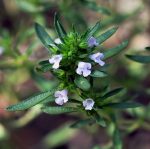 Summer savory is an annual and a member of the mint family, Lamiaceae, that also includes rosemary, thyme, and beebalm. It is native to southern Europe and the Mediterranean region. The plant has a well-branched root system and is bushy and highly aromatic with a sweet scent. It grows 1 to 1 ½ feet tall and has finely hairy stems and soft hairless linear leaves about an inch long. The leaves are gray green at first but develop purple hues by late summer or early fall. They grow in pairs from the stem without petioles. The flowers are white or pale pink and two-lipped. They are ¼ inch long and are produced in clusters of three to six in upper leaf axils from mid summer to frost. Summer savory has been grown from ancient times for the peppery thyme/mint flavor it can add to many dishes and makes a good addition to an herb garden. The genus name Satureja is the Latin name for the plant and, according to the ancient Roman writer Pliny, is a derivative of the word for satyr because the herb belonged to the mythical creatures. The specific epithet hortensis comes from the Latin word hortus meaning garden and refers to the cultivation of the plant in a garden.
Summer savory is an annual and a member of the mint family, Lamiaceae, that also includes rosemary, thyme, and beebalm. It is native to southern Europe and the Mediterranean region. The plant has a well-branched root system and is bushy and highly aromatic with a sweet scent. It grows 1 to 1 ½ feet tall and has finely hairy stems and soft hairless linear leaves about an inch long. The leaves are gray green at first but develop purple hues by late summer or early fall. They grow in pairs from the stem without petioles. The flowers are white or pale pink and two-lipped. They are ¼ inch long and are produced in clusters of three to six in upper leaf axils from mid summer to frost. Summer savory has been grown from ancient times for the peppery thyme/mint flavor it can add to many dishes and makes a good addition to an herb garden. The genus name Satureja is the Latin name for the plant and, according to the ancient Roman writer Pliny, is a derivative of the word for satyr because the herb belonged to the mythical creatures. The specific epithet hortensis comes from the Latin word hortus meaning garden and refers to the cultivation of the plant in a garden.
Type: Annual
Bloom: Clusters of white or pale pink two-lipped flowers from mid summer to frost
Size: 1- 1.5′ H
Light: Full sun
Soil: Average, medium moist, well-drained, lightly acidic
Hardiness: Not applicable
Care: Low maintenance
Pests and Diseases: None of significance
Propagation: Fresh seed
Companion Plants: Other herbs such as rosemary, oregano, and thyme
Photo Credit: Wikispecies